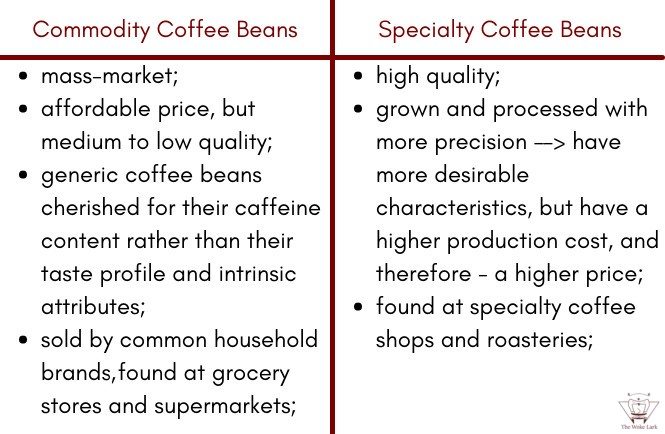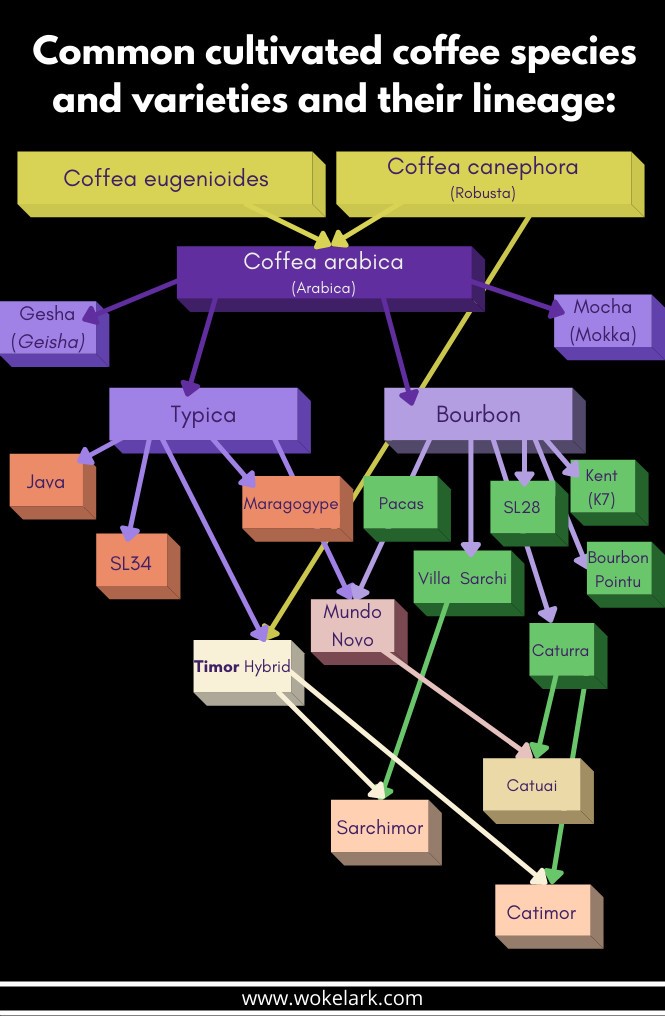You may drink coffee every day, but do you know what kind of beans your morning cup is made of?
In this beginner-friendly guide, I decided to shed light on the types of coffee beans and their key characteristics.
You may be aware that the label on your bag of coffee says “100% Arabica”, “Medium Roast”, “Single-Origin”, but do you know what all of that means? In this post, I’ll make sure to give you all the answers.
Click for Quick Navigation:
We can actually classify coffee beans into numerous different types, depending on the aspect we’re looking at – their origin, roast profile, genetic make-up, or the way they’re processed or traded. Nevertheless, I won’t be getting into too much detail and overwhelm you with too much information. I’ll just go over the most popular types and describe their key attributes.
This way you’ll get the basic knowledge that will help you become more confident when choosing the right coffee beans for you. Best case scenario, this post will inspire your curiosity and excite you to try out specialty coffee and taste (or sense) the difference between different types of beans yourself.
Without further ado, let’s dive in!

I had to share this infographic before we start for you to know what I mean when I use the words “commodity” and “specialty” throughout the post.
What are the Main Types of Coffee Beans
Coffee beans are actually seeds of the Coffea plant – a flowering tree or shrub that develops fruits, called “coffee cherries”.
Each cherry usually contains 2 coffee seeds (beans).
Photo by Og Mpango from Pexels
When discussing the types of coffee beans, most people refer to the two most commercially grown Coffea species – Coffea arabica (known as Arabica) and Coffea canephora (known as Robusta).
Arabica makes up about 60% to 70% of the world’s coffee produced each year, while Robusta accounts for 30% to 40%.
Considering their prevalence on the coffee market, Arabica and Robusta are definitely the two main types of coffee beans.
There is another Coffea species that’s worth noting in this guide – Coffea liberica, referred to as Liberica.
Liberica beans are often cited as the third most common type of beans available on the market.
Coffea liberica is mostly grown in the Philippines and a few other Southeast Asian countries.
In reality, Liberica coffee is pretty much consumed only where it’s grown and it’s rarely exported, because, to be honest, it’s not the best in terms of taste.
If exported, its beans are mainly used in blends. Despite that, some passionate coffee enthusiasts (like myself) seek Liberica beans in specialty coffee shops around the world, more driven by their curiosity than the beans’ overall reputation.
You may also come across a few online sources which suggest that there are actually four types of coffee beans.
The fourth one is Excelsa, which was thought to be a separate Coffea species, but it’s actually a variety of Liberica (Coffea liberica var. Dewevre).
Just like Liberica, Excelsa coffee is grown mainly in the Philippines and it’s hard to find its beans elsewhere.
Even though it captivates the interest of specialty coffee lovers, Excelsa coffee never really makes it to the average consumer’s cup.
Most of those species and their coffee beans are quite different from those that we use to brew coffee with, so they don’t draw any commercial attention.
Nonetheless, the conservation of the diversity in wild Coffea species is of key importance for the coffee industry.
Unfortunately, at least 60% of the species are threatened with extintion, which may be devastating for the future of the coffee sector. (Visit the links for more information)
In my guide, I’ll describe the two types of coffee beans that you come across daily – Arabica and Robusta.
Robusta (Coffea canephora)
The Coffea canephora species, commonly known as Robusta was discovered later than Coffea arabica in the late 19th century.
The species actually got its common name from its highly valued sturdiness.
Robusta could grow and fruit at lower altitudes and higher temperatures.
Furthermore, Robusta was more resistant to disease and it had twice the amount of caffeine of Arabica.
On top of that Coffea canephora plants produced a higher yield. So it’s pretty clear why Robusta quickly gained everyone’s attention – it was cheaper to produce and therefore – more profitable for producers.
So more and more people situated between the Tropic of Capricorn and the Tropic of Cancer started to grow Coffea canephora.
For the very same reasons, Robusta beans are the second most produced and widely spread type of beans to this day.
Unfortunately, Robusta coffee doesn’t have a great reputation when it comes to flavor.
Many people find the coffee prepared with this type of beans unpleasant in terms of taste.
Robusta coffee generally has a heavy mouthfeel and its flavor is often unbalanced and bitter in a harsh way.
Because of its lower acidity, sugar concentration, and lipid content, the taste profile of Robusta coffee is far from exciting.
Unfortunately, more often than not, Robusta beans leave a burnt rubber quality to the brew.
With that being said, Robusta has been used in espresso coffee blends for a long time, not only because it’s cheaper, but also because its beans are capable of producing more crema.
Anyway, nowadays the Robusta type of beans is mainly used for the production of instant coffee or as a filler in commodity coffee brands.
Instead of using 100% Arabica beans, mass-market coffee producers make blends of Arabica and Robusta to lower their cost and increase their profit.
As of today, you can rarely come across Coffea canephora on the specialty coffee scene.
With that being said, in line with the growth of the specialty coffee market, there is an increasing interest in finding properly grown, harvested, and processed Robusta beans.
There are more and more coffee enthusiasts who are eager to try out high-quality Robusta.
Naturally, the number of small roasteries that look for canephora varieties that are grown and processed with care to detail rises.
With all being said, it is possible to have coffee made with high-quality Robusta beans.
There are grades of quality within Robusta too, so don’t completely exclude this type of beans because of its bad reputation.
On the other hand, some people prefer Robusta over Arabica, no matter its quality. This is often because of the higher caffeine content of the former.
After all, there’s nothing wrong with looking for a way to get a higher dose of caffeine to get yourself going in the morning.
Arabica (Coffea arabica)
When speaking of the different types of coffee beans it’s just not possible to leave the Coffea arabica out.
This coffee species is definitely the most interesting one, and there are many reasons why its beans are the most widely spread around the world.
It’s generally considered that Arabica coffee beans are of higher quality than Robusta ones.
Compared to Robusta, Arabica coffee is mellower, more enjoyable.
At the same time, the taste profile of Arabica beans is more complex – with hints of fruits, pleasant perceived acidity, and sweet flavor notes.
The characteristics of Arabica coffee beans can largely vary depending on the exact Arabica variety your coffee is made of.
For example, the highly-priced “Geisha” coffee variety can produce a cup with an intense aroma and exceptional floral notes.
The SL-28 variety has larger than average coffee beans and it’s known to produce coffee with well-pronounced fruit flavors that are often compared to blackcurrant.
On the following infographic, you can see the lineage of the most common cultivated coffee species and varieties:
The taste profile of different coffee bean varieties isn’t the (only) reason why they start being cultivated.
For example, some coffee varieties are more resistant to disease, while others have a higher tolerance to drought.
The yield potential, as well as the ease of harvesting, are also factors that producers take into account when deciding whether or not to grow a certain coffee variety.
The key characteristics of different types of coffee beans are also influenced by the weather conditions at which they’ve been grown, how they’ve been harvested and processed
It’s also worth noting that not all the seeds that come from Coffea arabica species are of excellent quality.
Q graders determine the quality of coffee beans at their origin based on the standards set by the Specialty Coffee Association.
The graders assign a score from 0 to 100 to each coffee batch.
Beans with a score of at least 80 are considered specialty-grade.
Lower-grade beans are cheaper and are used by many commodity coffee brands.
So if the label of your store-bought bag of beans says “100% Arabica beans”, it doesn’t necessarily mean that you’re getting the best type of coffee. To be fair, it’s rather unlikely for you to find Arabica of great quality in the supermarket.
On the other hand, if you go to a specialty coffee shop, you’ll most likely be able to get a freshly roasted bag of high-quality beans of the Arabica type.
So Robusta is basically one of the two parents of Arabica (as seen on the coffee lineage infographic that I shared a bit earlier in the post).
It’s quite hard to find coffee beans from the less-known parent of the Arabica species – Coffea eugenioides.
Nonetheless, some determined coffee lovers have managed to get their hands on a bag of coffee beans of this rare type.
It turns out that having Eugenionides coffee is quite an extraordinary experience. It’s with a light mouthfeel, smooth, naturally sweet, and unlike Robusta – it isn’t bitter at all.
It’s quite intriguing to try out coffee prepared with this type of beans, even though a bag of Eugenionides is much more expensive than a regular bag of roasted coffee.
Coffee Bean Types Based on Origin
Coffee beans have always been traded by origin. That’s the reason why it’s not always clear which coffee variety (or varieties) is (or are) present in a particular batch of beans.
Most of the time we only know which part of the world the coffee’s been grown in.
There are two main types of coffee beans based on their origin – “single-origin” coffee beans and “blends”.
The blends consist of coffee beans that come from different countries or different coffee growing regions.
The beans of different origins have different aromas and characteristics which contribute to the final flavor profile of the blend.
There are both commodity and specialty coffee roasters who have great blending skills. They have the ability to combine several types of beans that may taste dull on their own and create a bland with a great flavor profile.
Most commodity coffee brands use coffee bean blends. This is understandable as blends provide more consistency, while the flavor of single-origin coffee varies broadly. If you like a certain blend of beans you will be able to get the same taste month after month and even year after year.
Selling single-origin coffee beans is more common in the world of specialty coffee.
Specialty coffee roasters are quite interested in finding out how origin impacts taste. When they buy high-quality beans from a certain region they prefer selling those beans on their own, not in a blend, so that the consumers can sense the highly valued original flavors.
Keep in mind, though, that you can’t be certain that single-origin coffee beans from a particular growing region will always taste good (or the same).
It’s impossible to make such generalizations, as multiple variables have an impact on the characteristics of the different types of beans. This means that this year’s single-origin Tanzanian coffee may have a surprisingly different flavor profile from next year’s one because of the different weather conditions the Coffea plant was exposed to.
With that being said, the origin of coffee may serve as an indicator of its quality.
For example, if you buy a bag of single-origin Ethiopian beans from your local roastery, you’ll likely be more than happy with your purchase.
Ethiopia is one of the most respected coffee origins in the world of specialty coffee. Single-origin Kenyan coffee also has an excellent reputation.
Contrarily, high-quality coffee coming from the Philippines or Vietnam is more of a rarity.
Types of Coffee Roasts
There are three main types of coffee beans based on their roast level – dark, medium, and light. Of course, the roast profile of coffee beans may be described as medium-dark, or medium-light, depending on the exact degree of roast.
During the process of roasting, the coffee beans start developing bold roast flavors.
The darker the roast, the more prevalent the roast flavors and aromas are.
It’s generally harder to sense the intrinsic flavor profile of the beans when they’re darkly roasted.
That’s why, more often than not, high-quality coffee beans are of light roast.
On the contrary – many coffee companies try to mask the inferior quality of the beans they sell by roasting them as dark as possible.
Needless to say, there are many high-quality darkly roasted coffee beans that you can get your hands on. So don’t be left with the impression that darkly roasted coffee is always a bad thing.
Furthermore, some types of coffee call for the use of a darker roast.
For example, traditional espresso is always made with medium or darkly roasted coffee beans. That’s the reason why the terms “espresso roast” and “dark roast” are often used interchangeably. Dark roast beans are also a staple in the making of a cold brew. Lighter roasts, on the other hand, are commonly used with the pour-over brewing method.
Final Words
To be fair, average coffee consumers rarely feel compelled to learn more about different types of coffee beans.
Most people who have coffee daily aren’t particularly concerned with the origin, variety, intrinsic flavor profile, and overall quality of their coffee.
They just need coffee as a source of caffeine. If it tastes decent – great, if not – you can always add a bit of creamer and sugar to mute its unpleasantness, right?
As long as it gets you going, it doesn’t matter whether it’s a light or a dark roast, Arabica or Robusta.
Even though I do care about all the aforementioned characteristics of coffee beans, I don’t judge the average coffee consumer.
After all, different people have different interests and priorities.
Not all of us have the time or desire to dive deeper into the world of specialty coffee.
With that being said, most (if not all) fans of specialty coffee were once commodity coffee consumers.
It comes a day in life when someone or something sparks your curiosity and you open your eyes to the exciting world of coffee and its intriguing diversity.
I hope that through my post I inspired at least one of you to go to your local roastery and try out coffee made with high-quality beans for the first time.
Suggested Post: How Long do Coffee Beans Last?





